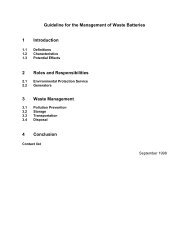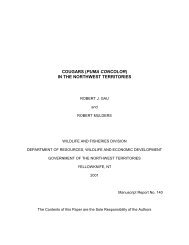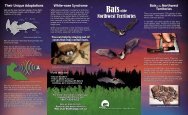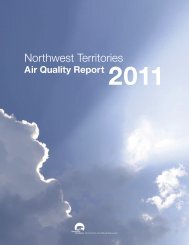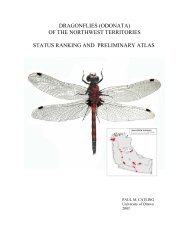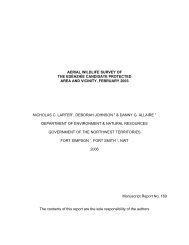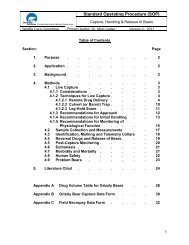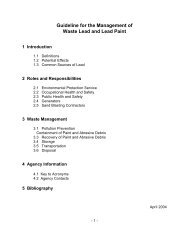Guideline on Waste Asbestos - Environment and Natural Resources ...
Guideline on Waste Asbestos - Environment and Natural Resources ...
Guideline on Waste Asbestos - Environment and Natural Resources ...
You also want an ePaper? Increase the reach of your titles
YUMPU automatically turns print PDFs into web optimized ePapers that Google loves.
<str<strong>on</strong>g>Guideline</str<strong>on</strong>g> for the Management of <strong>Waste</strong> <strong>Asbestos</strong>1 Introducti<strong>on</strong>1.1 Definiti<strong>on</strong>s1.2 Characteristics1.3 Potential Effects2 Roles <strong>and</strong> Resp<strong>on</strong>sibilities2.1 Envir<strong>on</strong>mental Protecti<strong>on</strong> Service2.2 Occupati<strong>on</strong>al Health <strong>and</strong> Safety2.3 Generators of <strong>Waste</strong> <strong>Asbestos</strong>2.4 C<strong>on</strong>tractors3 <strong>Waste</strong> Management3.1 Polluti<strong>on</strong> Preventi<strong>on</strong>3.2 Storage3.3 Transportati<strong>on</strong>3.4 <strong>Asbestos</strong> Abatement3.5 Disposal4 C<strong>on</strong>clusi<strong>on</strong>C<strong>on</strong>tact listApril 2004
<str<strong>on</strong>g>Guideline</str<strong>on</strong>g> for the Management of <strong>Waste</strong> <strong>Asbestos</strong>1 Introducti<strong>on</strong>This guideline provides general informati<strong>on</strong> <strong>on</strong> the proper management of waste asbestos.<strong>Waste</strong> asbestos is a c<strong>on</strong>taminant under the Envir<strong>on</strong>mental Protecti<strong>on</strong> Act (EPA) of the NWT<strong>and</strong> must be managed as a hazardous waste.<strong>Asbestos</strong> is a cancer causing substance. The public, workers, <strong>and</strong> the envir<strong>on</strong>ment must beprotected from any air-borne exposure to this material.This guideline is specific to the management of waste asbestos <strong>and</strong> should be read inc<strong>on</strong>juncti<strong>on</strong> with the <str<strong>on</strong>g>Guideline</str<strong>on</strong>g> for the General Management of Hazardous <strong>Waste</strong> In the NWT(referred to as the General <str<strong>on</strong>g>Guideline</str<strong>on</strong>g>). Secti<strong>on</strong> 2.2 of the EPA gives the Minister of <strong>Resources</strong>,Wildlife <strong>and</strong> Ec<strong>on</strong>omic Development the authority to develop, coordinate <strong>and</strong> administer theseguidelines.1.1 Definiti<strong>on</strong>s<strong>Asbestos</strong>Magnesium silicate minerals that occur naturally in fibrous forms. Theregulated (TDGR) asbestos types include: chrysotile, actinolite,anthopkyllite, tremolite (white), crocidolite (blue), amosite, mysorite(brown).Friable waste material A material which when dry can be crumbled, pulverized or reduced topowder by h<strong>and</strong> pressure.GeneratorTransport authorityThe owner or pers<strong>on</strong> in charge, management or c<strong>on</strong>trol of a hazardouswaste at the time it is generated, or a facility that generates hazardouswaste.The regulati<strong>on</strong>s c<strong>on</strong>trolling the management of hazardous waste underthat mode of transport. These include:Road <strong>and</strong> rail - Transportati<strong>on</strong> of Dangerous Goods Act (TDGA) <strong>and</strong>Regulati<strong>on</strong>s (TDGR)Air - Internati<strong>on</strong>al Civil Aviati<strong>on</strong> Organizati<strong>on</strong> Technical Instructi<strong>on</strong>(ICAO)Marine - Internati<strong>on</strong>al Maritime Dangerous Goods Code (IMDG).<strong>Waste</strong> <strong>Asbestos</strong><strong>Asbestos</strong> that is no l<strong>on</strong>ger useable for its intended purpose <strong>and</strong> isintended for storage, recycling or disposal. It includes any type ofmaterial with greater than 1% asbestos by weight.-1-
1.2 Characteristics<strong>Asbestos</strong> is a silicate mineral which is str<strong>on</strong>g, flexible <strong>and</strong> resistant to heat <strong>and</strong> chemicals.<strong>Asbestos</strong> was used in a variety of materials including: fireproof fabrics, gaskets, electrical <strong>and</strong>heat insulati<strong>on</strong>, chemical filters, brake lining, siding <strong>and</strong> c<strong>on</strong>crete reinforcement.1.3 Potential EffectsRespiratory exposure to asbestos particles <strong>and</strong> fibers causes cancer.The fibrous nature of asbestos is a health c<strong>on</strong>cern. Friable asbestos readily floats in air <strong>and</strong> iseasily inhaled. Due to the mineral nature it is not readily dissolved <strong>and</strong> may not be excretedfrom the body. If enough asbestos particles are taken into the respiratory tract cancer maydevelop.Envir<strong>on</strong>mental <strong>and</strong> occupati<strong>on</strong>al exposure to asbestos is primarily from air-borne sources. Thisincludes weathered or poorly maintained asbestos materials <strong>and</strong> particles from asbestosabatement (removal) projects. <strong>Natural</strong> exposures of asbestos (rock outcrops) <strong>and</strong> dust fromvehicle brake pad wear are bey<strong>on</strong>d the scope of this guideline.2 Roles <strong>and</strong> Resp<strong>on</strong>sibilities2.1 Envir<strong>on</strong>mental Protecti<strong>on</strong> ServiceThe Envir<strong>on</strong>mental Protecti<strong>on</strong> Service (EPS) of the Department of <strong>Resources</strong>, Wildlife <strong>and</strong>Ec<strong>on</strong>omic Development is the Government of the Northwest Territories’ (GNWT) agencyresp<strong>on</strong>sible for initiatives which c<strong>on</strong>trol the discharge of c<strong>on</strong>taminants <strong>and</strong> their impact <strong>on</strong> theenvir<strong>on</strong>ment. EPS is resp<strong>on</strong>sible for ensuring that envir<strong>on</strong>mentally acceptable managementprocedures, emissi<strong>on</strong> levels <strong>and</strong> disposal methods are maintained. EPS programs are appliedprimarily to Commissi<strong>on</strong>er’s L<strong>and</strong>, l<strong>and</strong>s administered by municipal governments or GNWTundertakings. Legislative authority is provided by the EPA <strong>and</strong> Pesticide Act. C<strong>on</strong>tact EPS fora listing of relevant regulati<strong>on</strong>s <strong>and</strong> guidelines.2.2 Occupati<strong>on</strong>al Health <strong>and</strong> SafetyWorker protecti<strong>on</strong> from air-borne asbestos particles is regulated by the Preventi<strong>on</strong> ServicesDivisi<strong>on</strong>, Workers` Compensati<strong>on</strong> Board. The <strong>Asbestos</strong> Safety Regulati<strong>on</strong>s, under the NWTSafety Act, require that employee exposure to hazardous air-borne asbestos be maintainedbelow specified levels. The exposure levels corresp<strong>on</strong>d to the type of asbestos <strong>and</strong> the friabilityof the material. C<strong>on</strong>tact the Preventi<strong>on</strong> Services Divisi<strong>on</strong> of the Workers’ Compensati<strong>on</strong> Boardfor the regulati<strong>on</strong>s <strong>and</strong> procedures required for the c<strong>on</strong>tainment of asbestos dusts <strong>and</strong> workerprotecti<strong>on</strong>.-2-
2.3 Generators of <strong>Waste</strong> <strong>Asbestos</strong>The resp<strong>on</strong>sibility for proper waste management rests with the generator <strong>and</strong>should be c<strong>on</strong>sidered as part of the cost of doing business.<strong>Waste</strong> asbestos is a hazardous waste. The owner (generator) of the asbestos is resp<strong>on</strong>sible forensuring the waste asbestos is properly managed from the time it is generated to final disposal.<strong>Waste</strong> asbestos must be safely removed, h<strong>and</strong>led, packaged, stored, transported, treated<strong>and</strong>/or disposed in accordance with this guideline <strong>and</strong> all applicable Acts <strong>and</strong> regulati<strong>on</strong>s.2.4 C<strong>on</strong>tractorsC<strong>on</strong>tractors can manage waste asbestos <strong>on</strong> behalf of a generator. However, the generator isresp<strong>on</strong>sible for insuring that the waste management method complies with this guideline, theGeneral <str<strong>on</strong>g>Guideline</str<strong>on</strong>g> <strong>and</strong> the requirements of other legislative authorities. (Including the <strong>Asbestos</strong>Safety Regulati<strong>on</strong>s under the Safety Act <strong>and</strong> the Transportati<strong>on</strong> of Dangerous Goods Act <strong>and</strong>Regulati<strong>on</strong>s (TDGR) or other transport authority).3 <strong>Waste</strong> ManagementMinimizing or avoiding the creati<strong>on</strong> of pollutants <strong>and</strong> wastes can be more effectivein protecting the envir<strong>on</strong>ment than treating them, or cleaning them up after theyhave been created.3.1 Polluti<strong>on</strong> Preventi<strong>on</strong>Canadian Council of Ministers of the Envir<strong>on</strong>mentPolluti<strong>on</strong> preventi<strong>on</strong> methods reduce or eliminate the creati<strong>on</strong> of waste. Polluti<strong>on</strong> c<strong>on</strong>trolpractices treat waste after it has been created. Polluti<strong>on</strong> preventi<strong>on</strong> opportunities for asbestosinclude the following:ReduceC C<strong>on</strong>sider using less hazardous materials i.e.: fiberglass, metals, wherever possible. Insome applicati<strong>on</strong>s there is no replacement for asbestos.ReuseC Encapsulati<strong>on</strong> of the existing asbestos by sealing with paint or an epoxy product, coveringwith paneling or other n<strong>on</strong>-asbestos materials may be c<strong>on</strong>sidered. The Preventi<strong>on</strong>Services Divisi<strong>on</strong>, Workers` Compensati<strong>on</strong> Board must be c<strong>on</strong>sulted prior to sealing areasthat c<strong>on</strong>tain asbestos.C N<strong>on</strong>-friable asbestos materials can be re-used ( i.e.: fire-break asbestos cementousboards), to reduce replacement costs <strong>and</strong> extend the life of the product.-3-
3.2 Storage<strong>Waste</strong> storage is not a l<strong>on</strong>g term soluti<strong>on</strong>.Store waste asbestos according to the following:CCCCCCStore in sealed, airtight c<strong>on</strong>tainers <strong>and</strong> labeled “<strong>Asbestos</strong>” as directed by the <strong>Asbestos</strong>Safety Regulati<strong>on</strong>s.Use c<strong>on</strong>tainers that are sound, sealable <strong>and</strong> not damaged or leaking.Label c<strong>on</strong>tainers according to the requirements of the Work Site Hazardous MaterialsInformati<strong>on</strong> System (WHMIS) of the Safety Act or the relevant Transport Authority iftransport to a disposal locati<strong>on</strong> is planned. (see Secti<strong>on</strong> 3.3 Transportati<strong>on</strong>).Protect c<strong>on</strong>tainers from the weather <strong>and</strong> physical damage.Storage should be in a secure area with c<strong>on</strong>trolled access.Train pers<strong>on</strong>nel in the safe use, storage <strong>and</strong> shipping procedures for waste asbestos.Only trained pers<strong>on</strong>s should have access to the storage area.The short term storage of waste asbestos is <strong>on</strong>ly acceptable as an interim measure to permittime for the collecti<strong>on</strong> of sufficient volumes for cost effective transport to a disposal facility.Storage of waste asbestos in quantities greater than 1000 kilograms for a period greater than180 days requires the site to be a registered hazardous waste storage facility. C<strong>on</strong>sult theGeneral <str<strong>on</strong>g>Guideline</str<strong>on</strong>g> or c<strong>on</strong>tact EPS for applicati<strong>on</strong> procedures.3.3 Transportati<strong>on</strong>The transport of waste asbestos requires proper classificati<strong>on</strong>, packaging, labeling <strong>and</strong>documentati<strong>on</strong> as required by the transport authority (air, marine, rail, road). Requirements forwaste generators <strong>and</strong> carriers are detailed in the General <str<strong>on</strong>g>Guideline</str<strong>on</strong>g>.Special Provisi<strong>on</strong>s 37 <strong>and</strong> 44 of TDGR are two exempti<strong>on</strong>s for road transport of wasteasbestos. These provisi<strong>on</strong>s allow for the substituti<strong>on</strong> of a shipping document for the hazardouswaste manifest, <strong>and</strong>, provided the shipping name <strong>and</strong> product identificati<strong>on</strong> number appear <strong>on</strong>the outer package or small c<strong>on</strong>tainer, labels are not required.The shipping document must include the following informati<strong>on</strong> <strong>and</strong> should be mailed or sent byfacsimile to EPS:- Date of c<strong>on</strong>signment- C<strong>on</strong>signor identificati<strong>on</strong>, mark or signature- Shipping name- Product Identificati<strong>on</strong> Number- QuantityFor road transportati<strong>on</strong> purposes, waste asbestos can be classified in the following ways,depending <strong>on</strong> the type of asbestos.-4-
Shipping Name:Shipping Name:Shipping Name:<strong>Waste</strong> White <strong>Asbestos</strong>P. I. N.: UN 2590Classificati<strong>on</strong>: 9.1Packing Group: lllSpecial provisi<strong>on</strong>s: 37,44<strong>Waste</strong> Blue <strong>Asbestos</strong>P.I.N.: UN 2212Classificati<strong>on</strong>: 9.1Packing Group: lllSpecial provisi<strong>on</strong>s: 37,44<strong>Waste</strong> Brown <strong>Asbestos</strong>P.I.N.: UN 2212Classificati<strong>on</strong>: 9.1Packing Group: lllSpecial provisi<strong>on</strong>s: 37,44Further c<strong>on</strong>sultati<strong>on</strong> with the transport authority is recommended.Generator numbers, waste manifests <strong>and</strong> registered hazardous waste carrier lists are availablefrom the Envir<strong>on</strong>mental Protecti<strong>on</strong> Service.3.4 <strong>Asbestos</strong> AbatementPreventi<strong>on</strong> of asbestos fibre release into the air is the primary objective of allasbestos abatement projects.The removal of asbestos materials requires a thorough underst<strong>and</strong>ing of the potential hazards<strong>and</strong> knowledge of measures available to prevent worker, public <strong>and</strong> envir<strong>on</strong>mental exposure toasbestos fibers.The <strong>Asbestos</strong> Safety Regulati<strong>on</strong>s require that employers c<strong>on</strong>ducting an asbestos removalproject provide the following training to workers who are likely to come in c<strong>on</strong>tact with asbestos:(a) dem<strong>on</strong>strati<strong>on</strong> <strong>and</strong> instructi<strong>on</strong> in the use of all protective equipment;(b) the safe h<strong>and</strong>ling <strong>and</strong> disposal of waste asbestos;(c) health educati<strong>on</strong> including informati<strong>on</strong> relating to pneumoc<strong>on</strong>iosis, lung cancer <strong>and</strong>the effects of smoking; <strong>and</strong>,(d) any other informati<strong>on</strong> a safety officer c<strong>on</strong>siders necessary.Other requirements, such as soaking the asbestos with water through its entire thickness priorto disturbing are designed for safety purposes.Materials c<strong>on</strong>taining n<strong>on</strong>-friable asbestos, such as asbestos cementous board (used as buildingsiding), ceiling tiles, linoleum, tar papers, are generally n<strong>on</strong>-hazardous if they remain intact.However, if these are broken or shredded, asbestos fibers may be released into the air.Minimal safety apparel is required when proper h<strong>and</strong>ling procedures are exercised. C<strong>on</strong>tact thePreventi<strong>on</strong> Services Divisi<strong>on</strong>, Workers` Compensati<strong>on</strong> Board, for more informati<strong>on</strong> <strong>on</strong> workerprotecti<strong>on</strong> or to obtain a copy of the regulati<strong>on</strong>s.-5-
The names <strong>and</strong> locati<strong>on</strong> of asbestos training centers are available by c<strong>on</strong>tacting the wastemanagement associati<strong>on</strong>s listed in Appendix ll of the General <str<strong>on</strong>g>Guideline</str<strong>on</strong>g>.3.5 DisposalTwo opti<strong>on</strong>s are available for the disposal of waste asbestos.Burial at the local l<strong>and</strong>fill. Approval for local l<strong>and</strong>fill disposal must be obtained from themunicipal authority. Acceptance of the asbestos materials by the local authority must bec<strong>on</strong>firmed to EPS by teleph<strong>on</strong>e or in writing. This ensures that the municipality is registered asa receiver of waste asbestos.At the l<strong>and</strong>fill, the waste asbestos shall be immediately buried <strong>and</strong> covered with <strong>on</strong>e half meterof cover material (two feet). Cover materials can be locally available soils, refuse or othermaterials provided the asbestos c<strong>on</strong>tainment is not ruptured. If a l<strong>and</strong>fill practices openburning, waste asbestos should be placed in a dedicated trench isolated from the burning. Theexcavated soils from the trench should then be used to cover the asbestos to the requireddepth.In additi<strong>on</strong>:-the excavati<strong>on</strong> must be isolated from future burning activities.-the asbestos waste should be buried where it will not be disturbed.-the locati<strong>on</strong> of the asbestos should be maintained <strong>on</strong> a map or diagram of the propertyby the municipal authority for future reference.The sec<strong>on</strong>d disposal opti<strong>on</strong> for asbestos is to c<strong>on</strong>tract a registered waste managementcompany. These companies can be c<strong>on</strong>tacted through their associati<strong>on</strong>s listed in Appendix II ofthe General <str<strong>on</strong>g>Guideline</str<strong>on</strong>g>.C<strong>on</strong>siderati<strong>on</strong> will be given to proposals for alternate disposal methods that provide a level ofenvir<strong>on</strong>mental protecti<strong>on</strong> equivalent to complying with this guideline. The Envir<strong>on</strong>mentalProtecti<strong>on</strong> Service may approve the method, subject to c<strong>on</strong>diti<strong>on</strong>s.-6-
4 C<strong>on</strong>clusi<strong>on</strong>This guideline presents a brief introducti<strong>on</strong> into the management of waste asbestos. It isintended as a source of basic informati<strong>on</strong> <strong>and</strong> should be read in c<strong>on</strong>juncti<strong>on</strong> with the <str<strong>on</strong>g>Guideline</str<strong>on</strong>g>for the General Management of Hazardous <strong>Waste</strong> in the Northwest Territories.For more informati<strong>on</strong> c<strong>on</strong>tact:1) Envir<strong>on</strong>ment Divisi<strong>on</strong>Department of Envir<strong>on</strong>ment <strong>and</strong> <strong>Natural</strong> <strong>Resources</strong>600, 5102-50 AvenueYellowknife NT X1A 3S8Ph<strong>on</strong>e: (867) 873-7654 Fax: (867) 873-02212) Motor VehiclesDepartment of Transportati<strong>on</strong>76 Capital Drive, Suite 201Hay River NT X0E 1G2Ph<strong>on</strong>e: (867) 874-5000 Fax: (867) 874-22723) Preventi<strong>on</strong> Services Divisi<strong>on</strong>Workers’ Compensati<strong>on</strong> BoardBox 8888Yellowknife NT X1A 2R3Ph<strong>on</strong>e: (867) 920-3888 Fax: (867) 873-4596-7-



